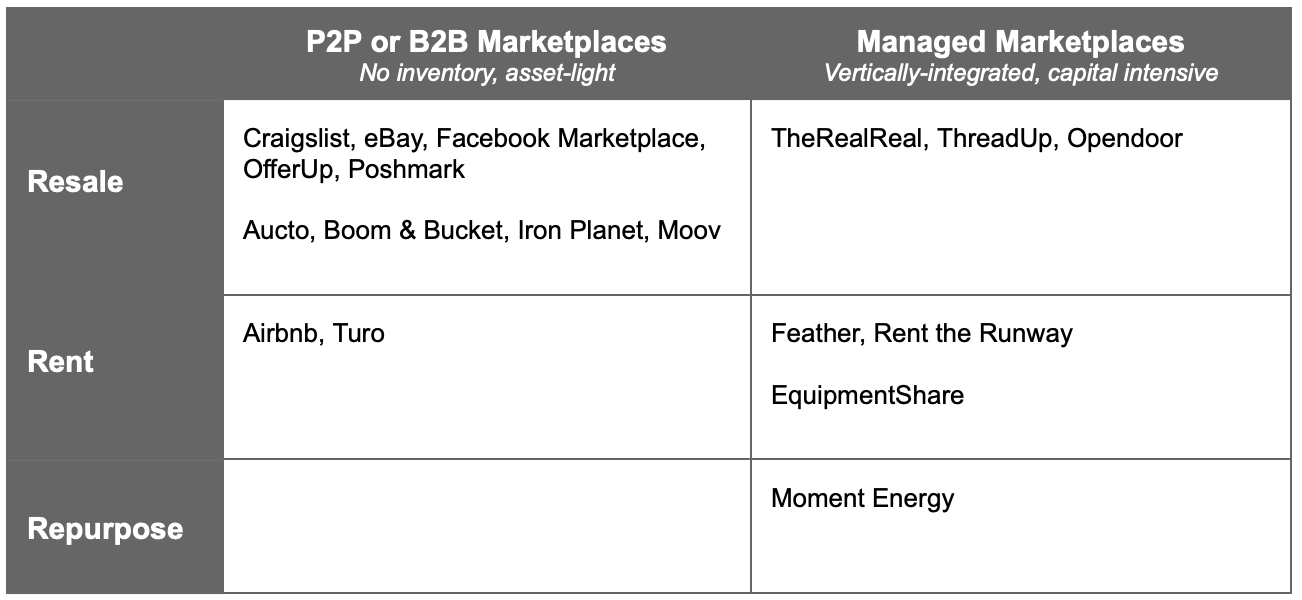Over the past 18 months, we’ve been increasingly focused on investing in climate and energy…
Energy/Climate
Since sharing an update on our areas of interest in climate and energy, we received a lot of feedback and met some great startups. Many of these discussions have centered around the circular economy. Upon reflection, it’s clear that there is synergy between the circular economy and our longstanding focus on marketplaces with their network […]
Over the past 18 months, we’ve been increasingly focused on investing in climate and energy…
Eighteen months have passed since I wrote about Version One’s areas of interest in climate…
Since sharing an update on our areas of interest in climate and energy, we received a lot of feedback and met some great startups. Many of these discussions have centered around the circular economy. Upon reflection, it’s clear that there is synergy between the circular economy and our longstanding focus on marketplaces with their network effects / flywheel effects (we wrote about the strength of network effects in this oldie resource, our Guide to Marketplaces).
The key concept behind the circular economy is reuse: to reduce the resource inputs and to reduce waste. The idea of reuse is far from new and we commonly know it as resale and rent.
And what’s often behind a resale or rent transaction? Marketplaces. You’re probably familiar with many resale or rent marketplaces, with category leaders sprouting out of specific verticals – from fashion, electronics, books, cars, home, equipment, furniture, and more. We’ve included a sampling of these in the table below. Note that it is not intended to be an exhaustive list and covers physical goods only.

And while resale/rental marketplaces aren’t new, I hope more startups emerge so we can tackle waste together. Some thoughts:
“Pure” versus Managed Marketplaces
Some reuse marketplaces serve as a broker that simply facilitates a connection between buyer and seller. They may integrate payments, conflict resolution, trust initiatives, etc. Others are vertically integrated or managed by taking inventory and handling more aspects of the transaction (e.g. cleaning, repairing, shipping, etc.) to remove even more friction between buyers and sellers.
In choosing a model, a marketplace needs to balance the effect of a better buyer experience with the downside of additional costs and complexity. We wrote about this in detail in the Guide to Marketplaces (check out “Marketplace types”, then “managed marketplaces”). However, it might just be that physical infrastructure is critical for circular economy marketplaces.
For instance, reusable plastics have captured a lot of attention recently. As many cities adopt a ban on single-use plastics, we’re seeing companies building for this circular economy: Boox, Dispatch Goods, Friendlier, Reusables, Suppli, and Topanga. While we believe that a marketplace here is inevitable, it will most likely need to be managed (i.e. very operations-driven with tech as a complement) to handle the plastics lifecycle of Collection –> Repair and Sanitization –> Redistribution.
I’ve previously talked about the possibility of an OS to power the circular economy, and am curious to see what value software will unlock down the road once the infrastructure exists. Perhaps it’s in the insights or data on consumer behaviour? Or maybe there can be a standalone OS with different partners representing different parts of the process that can plug into it modularly, so that the platform itself can be asset-light in the future?
A Third Category: Repurpose Marketplaces
The third row of the table introduces a new category: repurpose. This is “the process by which an object with one use value is transformed or redeployed as an object with an alternative use value”.
A great example of repurposing is Moment Energy, who converts EV batteries into energy storage units. When you recycle an EV battery, you dispose of the battery’s heavy toxic chemicals, so they don’t contaminate the environment.That’s important, but when the average EV battery is retired from a car, it still has 80% life left. Moment Energy gives these batteries a second life, producing a highly affordable energy product, while reducing lithium waste.
Currently, Moment Energy is vertically-integrated. They source batteries from many different OEMs, repurpose them into an energy storage unit, and then sell that energy storage to commercial and industrial partners, microgrids and off-grid, utilities, etc. Moment’s infrastructure is important, but it’s the software that makes this product possible. The team is building a novel battery management system (BMS) specifically optimized for second-life batteries of different chemistries.
In the future, we can imagine Moment evolving into a more asset-light model, as its BMS is licenseable and can thus become the main value-driver of the business.
TL;DR
In summary, marketplaces have been powering the circular economy for a long time – with resale and rent marketplaces that are either pure connectors or managed. But as we see in the reusable plastics example, circular economy marketplaces may rely more heavily on physical infrastructure, with software taking a secondary, enabling role. And finally, I’m also excited about the emergence of a new “repurpose” category, especially when software makes repurposing possible!
If you’re building a resale, rent, or repurpose platform, especially where software is the main value driver, I’d love to learn more (angela at versionone dot vc). Let’s tackle climate change, waste and pollution together 🙂
Special thanks to Mike Williams and the Everything Marketplaces community for their help on this post.
Portfolio
It’s hard to believe we’re already three quarters into the year. At V1, we’re all about finishing strong, and Q3 gave us plenty of reasons to be excited about what’s ahead. As always, we’ve rounded up a quick snapshot of the action across our portfolio from the past quarter: Funding announcements We welcomed TRIC Robotics […]
The V1 family kicked off the new year with fresh energy and no shortage of…
Fall is in the air and we are heading into the last quarter of 2023.…